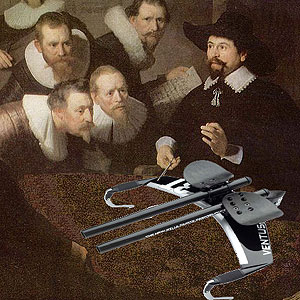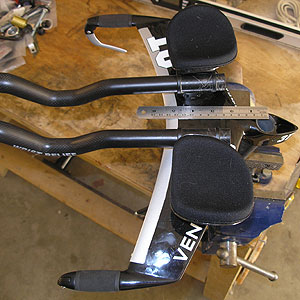3T Brezza II Nano
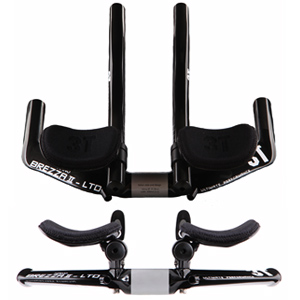
The 3T Brezza II Nano is the single most important gift to tri bike aerodynamics of 2011. But it's not the bar itself that's of prime importance, rather what the bar represents.
The year was somewhere between 1989 and 1991, I don't remember precisely. In one of the great bike rides in multisport history Shane Cleveland pedaled his Hooker Elite with a disc on the rear in the Desert Princess Duathlon World Championship. It was a 10k/60k/10k and in those days everybody showed up, including all the top triathletes.
The race was held in Palm Springs, and the bike course was in the shape of a box. There were 50mph winds that day, and depending on where you were on the box you enjoyed every way 50mph could be felt on your body.
Shane's equipment of choice included an aero helmet, with a full visor, and Scott 100k bars. These bars had no pursuit position at all. Shane rode them into the wind and uphill at the Desert Princess—no problem—and then along a roller coaster of ups and downs heeling into a broad reach—big problem—and then downhill with that tailwind, on his pursuitless bars, probably riding in excess of 50mph: E ticket. Shane was not favored in the race, but, as I recall he won the race that day. He earned it.
Like the Cinelli M71—the world's first modern clipless pedal and introduced 13 years before Look's first marketable clipless pedal—the 100k was too extreme, and not ready for prime time. If you want to see what these and handlebars like them look like, there's a forum thread on this from a year ago, with pics.
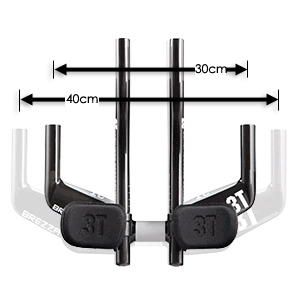
30cm Wide
Is the Brezza II Nano a narrow bar ready for prime time? It is an integrated aerobar system that features pursuits that are 30cm apart on center. This is crazy narrow. But, it's more civilized than the Scott 100k bar by a mile. You can plug brake levers into it, tape the hand position, and it's just like any other pursuit bar. Except it's, well, crazy narrow.
When I built this into a bike for a road test I chose to make a couple of alterations. I like the Ventus armrests, no news there to Slowtwitch readers, and I like the Wrist Relief extensions. This is how I retrofitted my Brezza Nano, before I took it out for the first ride.
What became apparent to me right away, on the first hill, was that there's no way to ride out of the saddle with these bars. Too narrow. But braking was okay. And turning was okay.
As I approached the second sustained hill on my ride, just for the heck of it I got out of the saddle again and, lo, it wasn't so bad. When seated, I almost always stay in the aero position while climbing. But I did place my hands on the pursuits, to see what that would be like, and I actually like it better than when the pursuits are wider. But I always have a "width problem" when I ride. I cut 8cm off my MTB bar when setting up my MTB bike. I hate riding wide bars.
On the third hill, I got out of the saddle, no problem. It appears just a case of motor learning, and familiarity with a very unconventional system. I've since grown to have no problem riding these bars out of the saddle.
Hand Bracing
These pursuits do employ one feature that may be uncomfortable for a lot of riders. The ends of the pursuits are straight. No upturn at the end. So, it's hard for some folks to brace their weight, either when braking, or when climbing (for those who climb with hands on pursuits). For these folks, Felt's Tri-Tip Aerobar Grips may be the solution (or another product that accomplishes this). I see no reason why this Felt product could not be employed successfully on 3T's Brezza bar or any other similarly shaped bar.
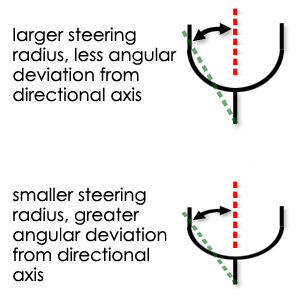
Steering Lever
I'm out of my depth here when trying to describe the mechanics I write about below. There is an angle formed by the bike's directional axis (when the bike points straight ahead) and a line that represents the steering lever. I think that angle can be too acute. I think that in severe cases—speed wobble, U-turns, and surprise emergency maneuvers—the lack of a sufficiently-sized angle (I haven't yet named this angle; perhaps it already has a name and I just don't know it) might be a problem.
Consequently—and for reasons I don't yet fully understand—I think an ultranarrow pursuit position would be encumbered by an overlong steering lever. One thing I would like to see is bars like the Brezza Nano feature the very short steering lever one sees on, say, the Zipp Vuka Bull.
Too Narrow?
Is the Brezza Nano too narrow? It absolutely depends on the ability, experience, and confidence of the rider. To those who were fans of the Scott 100k and Scott Extreme bars, 3T has made you a gift.
But the larger point is whether pursuits need to be as wide as road bars. Road race bars are built under the correct assumption that the great majority of your time is spent on the hoods or the drops. Therefore, the ergonomic imperatives of, for example, shoulder width are of prime concern.
But pursuit bars are pretty much along for the ride. Like first aid kits, or spare tires and inflators, they aren't constantly in use. They're there for emergencies. The job of the pursuit bar, 95 percent of the time, is to be unobtrusive to the wind. The other 5 percent of the time the pursuit bar needs to steer and stop the bike in the rare circumstances where steering cannot be accomplished while in the aero position, and when decelerating is a requirement.
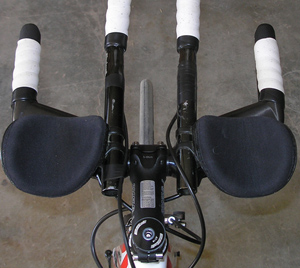
Therefore, the main job of the pursuit bar is to stay out of the wind and, with respect to 3T's other wind cheating bar—the original Ventus—the Brezza Nano seems to me to be even better: One way to beat a really aero object is for there to be no object at all.
The Virtue of Narrowness
Let us say that you aren't ready for a 30cm wide pursuit bar. The reason the Brezza Nano is so important is that it blows away the concept of ideal width and replaces it with the concept of acceptable width. Other companies have broached this, notably the original HED one piece bar, with pursuits that were narrower than typical. But while the current HED pursuit bars, like the Corsair, strive to strike an aero shape at their distal points, they are not particularly narrow as was their one-piece predecessors.
Typical pursuit bars today are, on center, 40cm or 42cm wide, end-to-end. Must they be? Road bars, yes. Road race bars for women may be 38cm on center, and that's about as narrow as you usually find road bars. But for triathlon, I don't see why 36cm, or 35cm, couldn't come into common use.
Furthermore, for the one legitimate purpose pursuit bars have that extends beyond braking and cornering, narrower is better. Some (maybe most) folks use the pursuits during seated climbing. I typically do not, and one reason is the very (to me) unergonomic placement of the pursuits. One inescapable aspect of tri bikes is the forward placement of the rider's weight. That can be done because the rider rests his upper body skeletally on the front of the bike. Once you're on your pursuits, you're not doing that. Now, to be sure, the effect is lessened, because once the slope pitches up the rider's weight is now incrementally moved off the front of the bike and back onto the saddle.
But that's a small detail somewhat ameliorating the larger point: a lot of the rider's weight is supported now by his hands. In my experience, my weight falls in between my hands when place on typical pursuits, during seated climbing. When the pursuits are narrower, my arms support my upper body, like a column.

Were I to pick a width that would be perfect for seated climbing, my pursuits would probably be between 30cm and 34cm wide.
The importance of the Brezza Nano is less what it is than the paradigm it represents. It disregards the mythology and blind habit that causes product makers to design something because the closest analog to it is a vestige of the bike industry from the pre-aerobar days. At my bike company, we started using pursuit bars as the base bar because the drop bar was inapplicable, once aerobars clip-ons were mounted. However, the pursuit bar's existence predated aerobars. When they were originally designed, they were the one and only position for—you guessed it—the pursuit.
Even then, we found that for aerobars with high profile armrests (chiefly Syntace) the elevation between the aerobar pad and the pursuit position was too great. We needed flat pursuits, that is, pursuit bars that did not descend in elevation after leaving the stem. We turned to Profile Design and asked them to make their "Stoker" bar in a 40cm width. What is a Stoker bar, you ask? It's a bar made for the stoker (rearward) position on a tandem.
So, as you can see, the antecedents of the modern aerobar pursuit position are all bars created for hands that never left their pursuit or stoker position. The pursuit position is not part of the starting line-up for triathletes. The pursuit position comes off the bench, for a very brief time, and then returns to the bench. If, in basketball, your bench players start throwing beer cups at the opposing players on the court, or hurl foul epithets at the officials, they cause more harm than the good they do when they're in the game.
Simply put, your pursuit bars, when you're not using them, need—aerodynamically—to sit down and shut up when they're not in the game. The 3T Brezza II Nano keeps its lips sealed.


